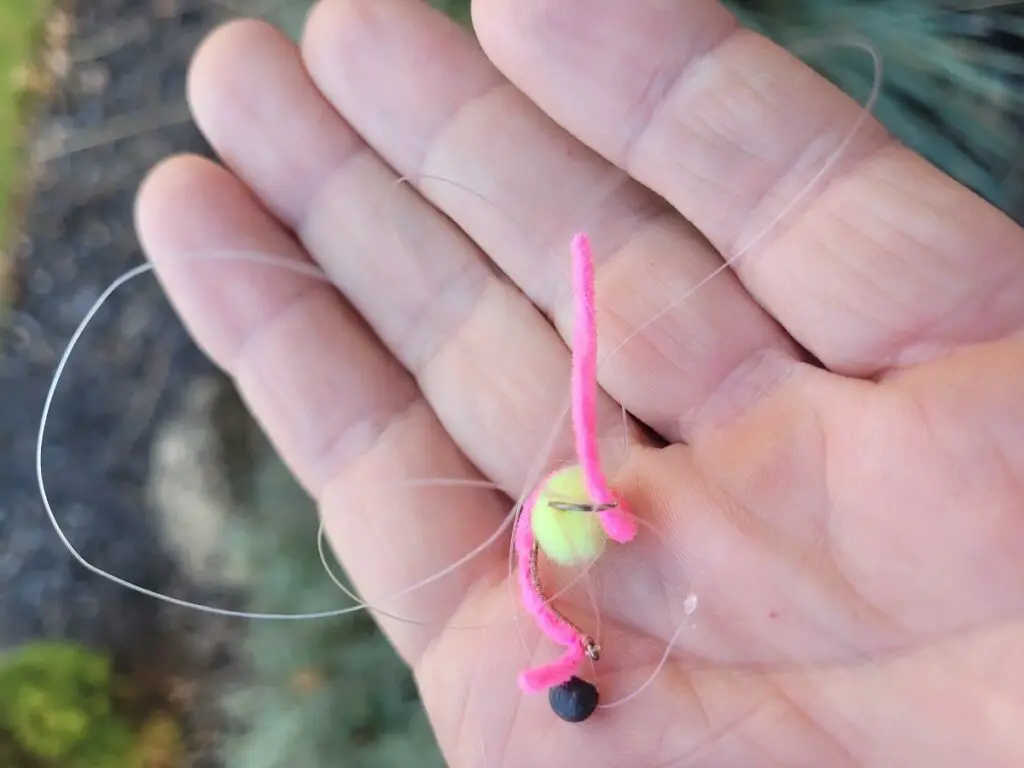Leader Tangles When Float Fishing And Bait Fishing

One of our readers asked, “Ok – suggestions/tips on how NOT to get my double bead set up tangled in my shot line while casting.” If you are not aware, I’ve been a guide for over 20 years, stood beside thousands of anglers, and seen leaders tangle when float fishing and bait fishing all the time.
It happens to many new and intermediate anglers, whether they are using 1 or 2 baits, and it happens with any type of bait fishing method.
If you have a combination of bait and weights, and/or a float, or even multiple baits, I call that “junk on the line”, and it’s going to tangle at times.
Sometimes, you get big tangles, and sometimes, you just find little knots in your leader that magically appear. Both are a problem, and both are preventable!!
Little knots may not seem like a big issue, but they are the weak link in your setup, and they can be the reason you break off a big fish. I remove these knots immediately. I will help you with both of these issues in this short article.
Just so you know, the tangling of your leader is not normal, and there is a way to fix it.
Since I’m not standing beside you on the river watching your cast, you’ll have to self-diagnose to determine what you are doing wrong. The first step is understanding why leader tangles happen in the first place, and I’ll tell you why and how to prevent it.
Why Leader Tangles Happen?
I teach my clients to learn how to keep the slack out of the line at all times. No slack, No tangles!!
You can not tie a knot into a straight line unless you bend that line and add slack!! So, stop adding slack, and always keep your line straight. I will tell you how.
For most guys, slack in the leader line, or bend in the leader, usually happens when the rig (your leader, weight, bait, and/or float) hits the water as everything lands in a heap, but tangles can also happen at the beginning of the cast as well.
If you are getting knots in the leader, the first step is to stop casting the way you’ve been casting!!
My Tips For Tangle Free Leaders
Pay attention to each of these points when you are fishing to see where your issues with leader knots might be happening. All of these tips are easy, they might just take a little practice.
Steady Your Rod Tip
Steady your rod tip when you have your rig reeled all the way in. A wiggly rod tip causes the leader (especially near the bottom) to bounce and possibly tangle.
Clients will ask me why they get little knots in the line; an unsteady rod tip will do it.
Learn how to steady your rod tip so your leader rig is not bouncing around. Tip number two will also help with this.
Don’t Reel Your Float To High
When you reel your float in after a drift, leave 3 to 4 feet of line between your float and your rod tip. This acts like a cushion to an unsteady tip and prevents tangles and knots in your leader.
If your tip is wiggly, it’s less likely going to tangle your leader if you have 3 to 4 feet of extra line out. Even when you are ready to cast, fight the urge to reel that float all the way up to your tip.
If you have a long float rod (10 to 14 feet), I’ll even leave 5 or 6 feet of line hanging, especially if it’s windy or my client has a wiggly rod tip.
I often like to leave enough line out that the extra line and leader combined are 3/4 the length of my rod up to the full length of my rod. This varies depending on the rod angle required for casting.
Try it! The next time you are out fishing, reel the float all the way to the tip, then wiggle the rod tip and see how much your beads and leader move, then try again with the float 3 or 4 feet below the rod tip.
Drag Your Bait
When you reel in, normally your rod tip is at about a 45-degree angle up from the water, so drag your two beads and leave them in the water beside you until you are ready to cast. Don’t lift them out of the water until your forward cast. This is a little harder to explain here. I’ll do a video soon.
But, keeping your baits in the water longer and dragging them keeps the leader straight, and even with a wiggly tip, they won’t tangle.
I will often leave a long line from rod tip to bottom bait, about 3/4 the length of my rod, I’ll dangle my bait inches below the surface to keep the slack out, then lift them gently as I go into my forward cast. I never get a tangle at the beginning of my cast.
Smooth Your Cast
Be sure the initial part of your cast is not jerky or fast. Try a slow, more lob-type cast. Smooth it out.
Some guys reel in, and then when they are ready to cast, they whip the rod tip back fast and then forward fast. Do not do this; this causes tangles.
Instead, slowly and gently drag your rod tip and leader back behind you, then lob-cast it out smoothly.
Your forward cast should start slightly slower and pick up speed.
Land Your Leader In A Straight Line
75% of leader tangles that I see happen when the baits hit the water!!
Lastly, and I do this all the time because I know it’s important, you must stop landing your rig in a pile!!
If your rig doesn’t land in a straight line, with the float in close to you and baits farthest away, you risk tangling.
So, make a nice smooth cast, and just before your rig, leader, float, weights, and baits are about to hit the water on your cast, slow the line down or/and slowly stop it in the air (just not abruptly) with your and or fingers.
I use my fingers on the line and gently squeeze the line with my thumb and index finger to slow the line down. This straightens out your line and leader and your baits so everything lands in a straight line.
This takes some practice, but I guarantee if you do all of these things, 95% of your tangle issues will disappear.
Leader Tangles When Float Fishing And Bait Fishing
If you have a question or comment or another tip regarding leader tangles when float fishing or bait fishing, let me know in the comment section below.
Good Luck,
Graham

Graham thanks for that information….. I gave up using bead and roe I will try this